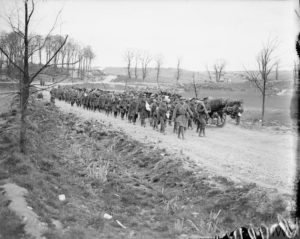Tuesday August 13th, 1918
Sick again. Light duty. Very warm. The remains of the 9th Battalion join us.
Becoming the 9th Battalion
Frank hasn’t got this quite right. While technically the remnants of the 9th and the 13th Battalions are being joined together, from now on the 13/Manchesters cease to exist. Instead the combined unit becomes the 9th (Territorial) Battalion of the Manchester Regiment. Their commander will be Lt-Col Morrell, formerly of the 13th and many of the officers will remain in post, supplemented by those from the 17th and the original 9th. So perhaps for Frank, the changes were not immediately obvious.
The 9/Manchesters
As the reconstituted 9th Battalion, they will be part of 199th Brigade of the 66th Division. Previously the 9th Battalion had been with the 198th Brigade within the same Division. There they had suffered heavy casualties during the first ten days of the Spring Offensive in March 1918.
The BWD for the 9th/Manchesters on March 21st 1918 reads: ‘On the morning at 4:30am the Battalion was ordered to take up Battle Positions owing to enemy activity. This was done through heavy gas bombardment which caused about 30 casualties. The Battalion went into action and continued in action till April 1st’.¹

For the next ten days, the Battalion was constantly on the move. Sometimes leapfrogging other units to help relieve situations or to allow other Divisions to retire. Or sabotaging bridges to slow down the enemy’s advance. Many of the entries seem to have been written up after the fact, the demands of battle taking precedence over record keeping. Read the complete diary entries for the rest of March here. Very quickly, their remnants became members of ‘composite battalions’.
The photograph shows a column of British infantry and artillery on the move new La Boiselle, March 25th, 1918 during the First Battle of Bapaume, Operation Michael.
As summarized in the final diary entry for March: ‘During the time from March 21st / 31st the Battalion was continuously in action and fought very hard. The casualties were 25 officers and 630 OR.’
On April 2nd, 1918, the remnants of the Battalion were billeted at Bissus-Bussuel and inspected by Brig-General Hunter MC, commander of the 198th Infantry Brigade. Ten days later they moved to ‘Coulonvillers and formed a company and Bn HQ of the Manchester Composite Battalion under Lt Col JL Heselton DSO.’ Subsequently many became part of a Training Cadre for American troops.
Read the diary entry for April and information on the training cadre and military awards here.
Honours & Awards
The commander of the 9th, Lt-Col EC Lloyd, DSO, wounded on the second day of fighting, received a Bar to his DSO. Captain Browne-Bagshaw also received a Bar to his MC. Three other officers were awarded the MC, Sergeant Moss (350714) received the Distinguished Conduct Medal and six other ranks earned the Military Medal.
The 13th are in distinguished company indeed.
13th (Service) Battalion War Diary – 13th August 1918 – Haudricourt
Work and training as per programme. Programme of Training and Work for 14th & 15th inst issued (Appendix No 3). Capt Cartman and 18 OR (Late 17th Bn) left for Base. Railway concessions will in future be grated to men on leave. The 13th (S) Bn Manchester Regt was absorbed by the 9th (T) Bn Manchester Regt. All rifles are being fitted with muzzle protectors. Capt P Darlington MC and Capt RH King (1/9th (T) Bn Manchester Regt) are attached for duty from today. 2Lt O Hamilton (late 1/9 T Manchester Regt) is taken and posted to D Coy. 23 OR are taken on from 30-7-18. 2Lt SE Gwinnell proceeded on leave to UK. 2Lt J Fazackerley rejoined from leave to UK. 2Lt C Hill MC proceeded on leave to UK.
References & Further Reading
¹ BWD for 9th Battalion / Manchester Regiment War Diary, March 21st 1918, Hervilly
* Q 8615, copyright Imperial War Museums
Regiments on The Long Long Trail,


